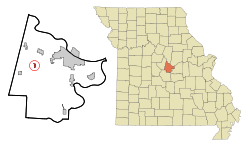Lohman, Missouri
| Lohman, Missouri | |
|---|---|
| City | |
 Location of Lohman, Missouri | |
| Coordinates: 38°32′37″N 92°21′53″W / 38.54361°N 92.36472°WCoordinates: 38°32′37″N 92°21′53″W / 38.54361°N 92.36472°W | |
| Country | United States |
| State | Missouri |
| County | Cole |
| Area[1] | |
| • Total | 0.36 sq mi (0.93 km2) |
| • Land | 0.36 sq mi (0.93 km2) |
| • Water | 0 sq mi (0 km2) |
| Elevation | 669 ft (204 m) |
| Population (2010)[2] | |
| • Total | 1,547 |
| • Estimate (2012[3]) | 163 |
| • Density | 452.8/sq mi (174.8/km2) |
| Time zone | Central (CST) (UTC-6) |
| • Summer (DST) | CDT (UTC-5) |
| ZIP code | 65053 |
| Area code(s) | 573 |
| FIPS code | 29-43652[4] |
| GNIS feature ID | 0721431[5] |
Lohman is a city in Cole County, Missouri, United States. The population was 1,547 at the 2010 census. It is part of the Jefferson City, Missouri Metropolitan Statistical Area.
History
Lohman was named for Henry Lohman.[6]
Geography
Lohman is located at 38°32′37″N 92°21′53″W / 38.54361°N 92.36472°W (38.543536, -92.364664).[7]
According to the United States Census Bureau, the city has a total area of 0.36 square miles (0.93 km2), all of it land.[1]
Demographics
The current mayor is Cyrus Meller.
2010 census
As of the census[2] of 2010, there were 163 people, 64 households, and 52 families residing in the city. The population density was 452.8 inhabitants per square mile (174.8/km2). There were 79 housing units at an average density of 219.4 per square mile (84.7/km2). The racial makeup of the city was 97.5% White and 2.5% from two or more races.
There were 64 households of which 26.6% had children under the age of 18 living with them, 70.3% were married couples living together, 4.7% had a female householder with no husband present, 6.3% had a male householder with no wife present, and 18.8% were non-families. 17.2% of all households were made up of individuals and 7.8% had someone living alone who was 65 years of age or older. The average household size was 2.55 and the average family size was 2.85.
The median age in the city was 42.6 years. 20.2% of residents were under the age of 18; 8.7% were between the ages of 18 and 24; 25.8% were from 25 to 44; 30.1% were from 45 to 64; and 15.3% were 65 years of age or older. The gender makeup of the city was 52.8% male and 47.2% female.
2000 census
As of the census[4] of 2000, there were 168 people, 60 households, and 52 families residing in the city. The population density was 376.0 people per square mile (144.1/km²). There were 68 housing units at an average density of 152.2 per square mile (58.3/km²). The racial makeup of the city was 100.00% White.
There were 60 households out of which 36.7% had children under the age of 18 living with them, 78.3% were married couples living together, and 13.3% were non-families. 13.3% of all households were made up of individuals and 5.0% had someone living alone who was 65 years of age or older. The average household size was 2.80 and the average family size was 3.08.
In the village the population was spread out with 24.4% under the age of 18, 8.9% from 18 to 24, 25.6% from 25 to 44, 26.2% from 45 to 64, and 14.9% who were 65 years of age or older. The median age was 40 years. For every 100 females there were 118.2 males. For every 100 females age 18 and over, there were 111.7 males.
The median income for a household in the city was $54,583, and the median income for a family was $59,375. Males had a median income of $35,000 versus $21,042 for females. The per capita income for the city was $22,666. About 5.1% of families and 3.7% of the population were below the poverty line, including 6.0% of those under the age of eighteen and none of those sixty five or over.
References
- ↑ 1.0 1.1 "US Gazetteer files 2010". United States Census Bureau. Retrieved 2012-07-08.
- ↑ 2.0 2.1 "American FactFinder". United States Census Bureau. Retrieved 2012-07-08.
- ↑ "Population Estimates". United States Census Bureau. Retrieved 2013-05-30.
- ↑ 4.0 4.1 "American FactFinder". United States Census Bureau. Retrieved 2008-01-31.
- ↑ "US Board on Geographic Names". United States Geological Survey. 2007-10-25. Retrieved 2008-01-31.
- ↑ Eaton, David Wolfe (1916). How Missouri Counties, Towns and Streams Were Named. The State Historical Society of Missouri. p. 279.
- ↑ "US Gazetteer files: 2010, 2000, and 1990". United States Census Bureau. 2011-02-12. Retrieved 2011-04-23.
| |||||||||||||||||||||||||||||
